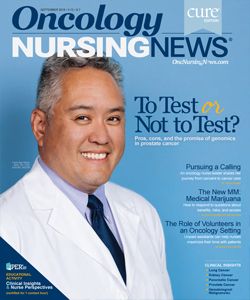To Test or Not to Test? Pros, Cons, and the Promise of Genomics in Prostate Cancer
There are still no simple answers to the question of screening for prostate cancer.
CAPTION

Photo Credit: Kara Brodgesell
Frank dela Rama
MSN, RN, CNS, AGN-BC, AOCNS
In 2012, when the United States Preventive Services Task Force (USPSTF) released its blanket recommendations against prostate-specific antigen (PSA) testing for prostate cancer, Steve Hentzen was a healthy 46-year old with no known risk factors. PSA screening was discouraged.1 However, his doctor’s insistence on testing saved his life. Hentzen received a diagnosis of advanced prostate cancer. He underwent a radical prostatectomy and later, IMRT radiation treatment. Although his story highlights the importance of PSA-based screening, the test is far from perfect, and the potential for unnecessary harm stemming from inconclusive and misleading results must be considered. Six years later, there are still no simple answers to the question of testing.
After the USPSTF made its recommendations, researchers noted an interesting trend. PSA screening among men age 50 years and older declined significantly, yet approximately 30% of men older than 65 years, with life expectancy estimated at less than 9 years, were still being screened.2 Recognizing the need for a more personalized approach, the USPSTF updated its guidelines in 2018 to include a shared decision-making component for men ages 55 to 69. Although PSA-based screening is effective for discovering cancers of the prostate early on, weighing the benefits against potential harm from overdiagnosis and overtreatment requires an informed discussion between physician and patient before making the decision to test.
Nurses play an important role and are an invaluable resource for patients by keeping them informed and encouraging men to discuss the subject of prostate cancer screening with their physicians. Frank dela Rama, MSN, RN, CNS, AGN-BC, AOCNS, is a prostate cancer nurse navigator at the Palo Alto Medical Foundation, a multispecialty clinic in Silicon Valley. He sees patients newly diagnosed with prostate cancer and helps guide them through the treatment process. Many of the men for whom he helps coordinate care and treatment are “pretty surprised” about their cancer diagnosis, dela Rama says. Often the patients, largely in the 45 to 60 years age group, reported feeling great and were simply following directions by their physicians to get screened.
Since he only sees patients after diagnosis, dela Rama’s perspective on PSA-based screening is colored by the benefit of early detection. He is well-versed about the adverse events of treatment and helps educate patients about various options available, such as MRI-guided biopsies for high-risk patients to aid visualization of the tumor. “Sometimes active surveillance is the best treatment,” he says.
COMPELLING ARGUMENTS
Hentzen is now the chairman and a cofounder of ProstateNetwork.org, a survivor-led nonprofit outreach and advocacy group for men diagnosed with prostate cancer. He is a strong proponent for routine screening and his argument is both personal and compelling.
Those who support recommendations against routine screening, however, have their own passionate reasoning for doing so. Prostate cancers are often slow-growing and asymptomatic, whereas harms associated with overdiagnosis and overtreatment, including infection, pain, bleeding, erectile dysfunction, and urinary complications, can be physically and psychologically traumatic. After analysis of two major studies and other reports on PSA screening, the National Cancer Institute (NCI) estimated that “for every 1000 men ages 55 to 69 years who are screened every 1 to 4 years for 10 to 15 years, about 1 death from prostate cancer would be avoided.”3 False-positive results are not uncommon, and treatment for confirmed disease that might not have otherwise been problematic, can negatively affect quality of life.
For many physicians, engaging patients in a shared decision-making process can be a time-consuming and often uncomfortable endeavor. Fear of litigation, reluctance to discuss life expectancy issues, lack of knowledge, and time constraints are some of the reasons identified in a 2014 study as to why men were screened against recommendations.4 Addressing practice issues and providing professional education can help ensure that physi¬cians have the tools and resources needed to best serve their patients.
Efforts to improve the quality and specificity of PSA-based screening is ongoing, but more research is needed before the usefulness of newer tests such as PSA-velocity, -density, and free versus total PSA, is realized. Healthcare providers should have a solid understanding of implications for their patients by reviewing available information and staying informed about advances in research and applicability to practice. It is important to note that in addition to the widely publicized USPSTF recommendations, other, more comprehensive guidelines are available from organizations including the National Comprehensive Cancer Network and the American Cancer Society.
SHARED DECISION-MAKING
Effective shared decision-making keeps the patient’s best interest front and center. Although prostate cancer is the leading non—skin cancer and the second leading cause of cancer death in men, patients do not know what they need to. Fortunately, many resources are available to help educate men throughout the process, including important questions to ask along the way, details about treatment options, and where to go for help and support.
Prostate nurse navigators like dela Rama are often called on by primary care physicians, urologists, and nurse clinicians for resources and direction. They also offer community outreach services to better educate men about prostate cancer. “Sometimes patients may ask for an unnecessary test or treatment not covered by insurance,” dela Rama said, “and urologists express uncertainty about the usefulness of some tests.” Their expertise at navigating the complexity of treatment is beneficial to patients.
The good relationships nurses have with their patients enable them to provide exceptional care, dela Rama points out. “[Men] love to be independent. They want to ‘warrior through’ everything. Nurses can educate them on the pros and cons of testing, the importance of talking to their doctor, test interpretation, and timing of the tests.”
When it comes to baseline screening, for example, scheduling the PSA before the digital rectal exam is conducted helps yield more accurate test results. Advising patients to refrain from ejaculation and any physical activity that puts prolonged pressure on the prostate (eg, long bicycle or motorcycle riding) 3 days before having PSA levels drawn is also important for a more precise reading. In dela Rama’s opinion, “nurses educate better than anyone on the planet,” which is why staying abreast of current trends and treatments is vital.
As for the role of genomics in prostate cancer management, dela Rama explained that genomic testing is currently integrated into the process—after diagnosis and before treatment. By using genomic testing, some of which is covered by insurance, physicians can learn how “angry” or aggressive tissue samples are. This information can help guide decisions about active surveillance versus treatment, as well as determine the course and timing of treatment. The possibilities of genomics are just beginning to be realized. Additional research and increased funding for high-quality studies is needed to move prostate cancer care to a higher level of precision.
THE PERSONALIZED PROMISE OF GENOMICS
Steve Shak, MD, is co-founder, chief scientific officer, and chief medical officer of Genomic Health, the world’s leading provider of genomic-based diagnostic tests. In an interview with Oncology Nursing News®, he talked about genomic testing and how it can prevent overtreatment and address underdiagnosis. “We started the company with the dream to move away from the one-size-fits-all [approach]. Genomics helps us address illness in a more targeted way.”
Shak thinks of genomics as precision medicine. One of the tests developed by his company, the Oncotype DX Genomic Prostate Score (GPS), uses a small amount of material taken from an initial biopsy. “A complex series of procedures are then completed to quantify a set of 17 genes that tell us whether a prostate cancer is aggressive or not,” Shak explained. “While PSA testing may reveal a rising or high level, it is impossible to know without tissue whether there is a benign cause.” In this regard, genomic testing addresses the gap the USPSTF used as a basis for its recommendations. “The task force had reasons to be concerned,” he says. “If everyone gets a biopsy showing a little bit of cancer, it might lead to radical treatment and unnecessary procedures. It is not enough to do things right, we also need to do things smart.”
The promise of genomics is encouraging. Shak credits the growth in this area to the collaborative efforts of leading clinical researchers, patient advocates, the NCI, and other cancer organizations. Nurses also played a pivotal role as patient advocates and in helping men with prostate cancer enroll in appropriate studies. “That is how advances are made,” Shak says.
The goal is to get the right treatment to the right patient at the right time. “We have innovations; when we spare patients from unnecessary treatment, we also save the healthcare systems’ dollars that could be spent better on other things. Cost effectiveness matters.”
The Oncotype DX GPS is covered by Medicare and multiple private insurance companies, and other genomic tests are available on the market, each with specialized purposes, some of which may also be reimbursable by insurance or Medicare coverage.
ASKING A BETTER QUESTION
For now, the question of conducting PSA-based screening for prostate cancer is best answered through informed decision-making between a man and his physician. “Doctors need to cover everything,” Hentzen stresses. “We should not expect men to have knowledge about this complicated subject.” Hentzen is doing his part to help lower the rates of advanced diagnoses through targeted outreach and education.
PSA tests are not definitive and not all biopsies are created equal. Men, in conversation with their doctors, should decide what to do if screening results come back elevated before testing is conducted. Informed decision-making calls for more than a quick visit, and physicians must be prepared to discuss difficult topics such as life expectancy and untoward effects of treatment openly with their patients. Nurses can help by educating men and encour¬aging them to ask questions.
As the debate over prostate cancer screening continues, and the promise of genomics offers options for reducing harm, perhaps it is time to ask: Are we giving patients the best care we can offer? Every patient? If not, now is the time to start.
Ellen Rice Tichich, MFA, MSN, RN-BC is a clinical nurse educator and freelance health writer.
References
- Drazer M, Huo D, Eggener SE. National prostate cancer screening rates after the 2012 US Preventive Services Task Force recommendation discouraging prostate-specific antigen-based screening. J Clin Oncol. 2014;33(22):2416-2423. doi: 10.1200/JCO.2015.61.6532.
- Drazer M, Prasad S, Huo D, et al. National trends in prostate cancer screening among older American men with limited 9-year life expectancies. Cancer. 2014;120(10):1491-1498. doi: 10.1002/cncr.28600
- Final recommendation statement: prostate cancer: screening. U.S. Preventive Services Task Force website. uspreventiveservicestaskforce.org/Page/Document/RecommendationStatementFinal/prostate-cancer-screening1. Published May 2018. Accessed June 15, 2018.
- Prostate-specific antigen (PSA) test. National Cancer Institute website. cancer.gov/types/prostate/psa-fact-sheet. Reviewed October 4, 2017. Accessed June 15, 2018.

Key Advances in Cancer Survivorship Toxicity Management
July 15th 2022In this episode of The Vitals, Lidia Schapira, MD, FASCO, recounts highlights from the 2022 ASCO Symptoms and Survivorship track and underscores key takeaways for practitioners seeking to enhance the delivery of cancer survivorship care.


